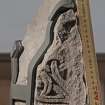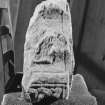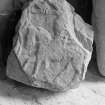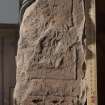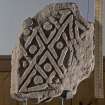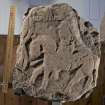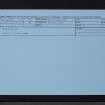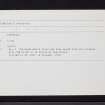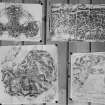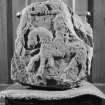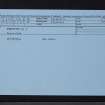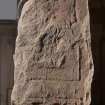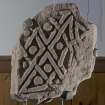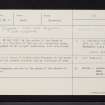Forteviot Manse, Cross And Cross-slab
Cross (Period Unassigned), Cross Slab (Early Medieval)
Site Name Forteviot Manse, Cross And Cross-slab
Classification Cross (Period Unassigned), Cross Slab (Early Medieval)
Alternative Name(s) Forteviot Nos. 3 And 4
Canmore ID 26541
Site Number NO01NE 11
NGR NO 0514 1747
Datum OSGB36 - NGR
Permalink http://canmore.org.uk/site/26541
- Council Perth And Kinross
- Parish Forteviot
- Former Region Tayside
- Former District Perth And Kinross
- Former County Perthshire
Forteviot 3, Perthshire, cross-arm fragment
Measurements: H 0.30m, W 0.25m, D 0.15m
Stone type: sandstone
Place of discovery: NO 0514 1747
Present location: at Forteviot parish church.
Evidence for discovery: when recorded for ECMS in the late nineteenth century, the stone was in the garden of the manse at Forteviot.
Present condition:
Description
This arm is quadrangular in shape and belonged to a ringed cross with circular armpits, the ring of which was carved on two levels forming a T in section. Within a plain flat-band border, the arm is carved in relief with triangular interlace in which the interstices contain a pellet. The end of the arm also bears triangular interlace, here with median-incised cords. The ring bears a simple two-cord twist.
Date range: ninth or tenth century.
Primary references: ECMS pt 3, 324, 326; Aitchison 2006, 109-10; Hall 2011, 143-4.
Desk-based information compiled by A Ritchie 2018
Forteviot 4, Perthshire, possible cross-shaft fragment
Measurements: H 0.40m, W 0.36m, D 0.18m
Stone type: sandstone
Place of discovery: NO 0514 1747
Present location: at Forteviot parish church.
Evidence for discovery: when recorded for ECMS in the late nineteenth century, the stone was in the garden of the manse at Forteviot.
Present condition: trimmed and badly weathered.
Description
With its solitary horseman carved in low relief, this fragment may have belonged to the top of the cross-shaft of which no 1 was the basal portion. The scalloped roll moulding that survives on the left-hand corner suggests that it could be the cusped lower arm of a free-standing cross. The horse and rider face left, and the warrior carries a spear in his right hand, but the details are sadly blurred by weathering.
Date range: ninth century.
Primary references: ECMS pt 3, 324, 326; Aitchison 2006, 110, 113-14; Hall 2011, 144.
Desk-based information compiled by A Ritchie 2018
NO01NE 11 0514 1747
See also NO01NE 10.00.
(Area NO 052 174) In the garden of the Manse at Forteviot is a fragment of the arm of a sandstone cross, and a fragment of an upright cross-slab, both sculptured.
J R Allen and J Anderson 1903.
There is no trace of either cross-fragment in the manse garden and the present minister has no knowledge of them.
Visited by OS (J T T) 5 November 1965.
Both fragments are now in the porch of the church at Forteviot.
Information contained in letter from J Close-Brooks, National Museum of Antiquities of Scotland (NMAS) to OS, 20 April 1978.
























